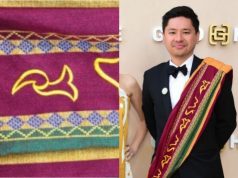
Conversations about an academic costume dominated Twitter on Wednesday after a Filipino-American wore it at the 2nd Annual Gold Gala of Gold House in Los Angeles.
ESPN program host Pablo Torre, a Harvard University graduate, shared photos of him attending the event which honors trailblazing Asian American and Pacific Islander creatives worldwide.
The event is hosted by Gold House, an organization describing itself as a leading cultural ecosystem uniting, investing, and championing Asian Pacific creators and companies.
Torre wore a suit with a bow tie and had the “Sablay,” the official academic costume of the University of the Philippines, draped over his left shoulder.
According to Torre, it was his father’s, who allowed him to borrow it for a night.
“So, just wanted to answer a couple questions about the sash I’m wearing here, which is called a sablay. And this specific one proudly belongs to graduates of the University of the Philippines,” he said on Instagram on May 9, Tuesday.
“I didn’t go to UP. But both of my parents, and both of their late fathers, did. So shoutout to my dad for letting me borrow his sablay for one night, so I could pay tribute to all of them,” Torre added with a Philippine flag emoji.
“P.S. Special thanks to the (goat emoji), @msleasalonga, whose presence visibly broke my brain,” he continued, tagging the account of theater legend Lea Salonga.
The journalist’s post has earned more than 5,000 likes so far.
View this post on Instagram
His photos, which featured him wearing an academic costume of an institution of which he was not a graduate, spurred several reactions.
For some, Torre was able to give representation when he wore the maroon-colored sablay.
“Okay, I know some of us in the UP Community have this obsession on who can [or] should wear the sablay, and I kinda went ‘what??’ when I saw this,” a Twitter user, who claims to be from UP Diliman, wrote.
“Having said that, his dad is a UP [alumnus] and Pablo’s from Harvard, so yeah, he can wear that whenever he wants. REPRESENT,” he added.
“I’m from UP. Wore the sablay back in ‘93. If I’m not mistaken, I think we’re the first to do so. I don’t see anything wrong if he wants to wear it to honor his parents and ancestors. I’d find it wrong if it’s worn by someone pretending to be a UP grad,” a Filipino on Facebook wrote.
“So what, then? At least he is proud of his heritage. Hindi [patalinuhan] ang labanan dito. Be proud that UP is being recognized (although mali nga lang, he should be wearing barong and is attending academic occasions). But overall, the Sablay is used to symbolize nationalism and ethnicity,” wrote another Pinoy.
Others, however, were not amused by Torre’s outfit. Some members of the UP community argued that the sablay represented their “blood and tears” as students who had to earn the right to wear it.
“As an alumna, this is so disrespectful??? I worked hard for 5 years to earn [that] sablay and wear it. And you, who isn’t even a graduate of the university, used it as a costume and even wore it on top of a black suit???? TAKE. IT. OFF, ” a Twitter user wrote.
“The only time I got to wear mine like that was during my graduation ceremony and it symbolizes the fruit of my five years of ups and downs at the university. I don’t know when I’ll ever get to wear it again. Now you’re telling me some people just wear it like a costume?” another online user tweeted.
“UP was already difficult to get into, it’s even harder to get out of while earning that Sablay. It’s a badge of honor and a source of our pride as alumni of that university, so seeing it being worn by just anyone kinda devalues the meaning of it all,” the user added.
“Bakit ka nag-sablay kung ‘di ka UP alum? Read his reply and it’s his dad’s. Personally offended by this [because] it’s so hard to wear that freaking cloth. Cried so much the first time I wore it during grad [graduation] shoot. It’s the cherry on top of all my blood, sweat, and tears,” commented another Pinoy.
“[Wouldn’t] have any problems or issues if he was an alum, but it comes out to me that the sablay was used as a fashion accessory. Although, I understand the respect that he has for it. But you have to earn that sablay [before you] can wear it,” the Twitter user added.
What does UP say about the sablay?
The UP, the country’s national university, deems the sablay as its official academic costume.
It replaced the traditional mortarboard or cap and toga in graduation ceremonies beginning in 2000.
On its website, the university said that the term “sablay” refers to an indigenous loose garment traditionally used for formal occasions.
“The Sablay symbolizes our nationalism and the importance we put upon our indigenous culture, which are among the values learned from the University,” it added.
Each element of UP’s sablay also holds meaning.
“The Sablay, as the academic costume, is adorned with ukkil and geometric elements. The ukkil represents the growth of knowledge while the triangles and chevrons, as geometric patterns, are common design elements across indigenous cultures in the Philippines,” it said.
“The University’s acronym, UP appears as a symbol on the Sablay. This symbol is based on the baybayin for U and P, but it has been designed to represent the University’s indigenous acronym itself, and is not meant to be read in a syllabic way as the corresponding baybayin characters are,” the institution added.
The UP said that “due respect should be given to the Sablay” since it is the university’s official academic costume.
“Therefore, it should be used only during academic functions and activities such as: Recognition Programs, Commencement Exercises, Investiture of Chancellors and Presidents, Awarding of Honoris Causa, Other academic activities requiring the academic costume, [and] Official photo taking,” it added.
The university said that the sablay should only be worn with formal attire “as a sign of respect for the official academic costume and to preserve the solemnity and dignity of the occasions when it is worn.”
For men, the sablay should be paired with a barong top in either ecru, beige, or cream, formal black pants, and black shoes and socks.
There is also a meaning to how the sablay is draped over the shoulder.
Before the conferment of degrees, students are supposed to drape it over their right shoulder. They will then simultaneously shift it to their left shoulder in a ceremony to signify their status as graduates.
For UP, the shifting of the sablay is “symbolic.”









